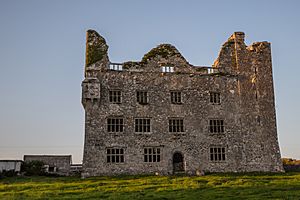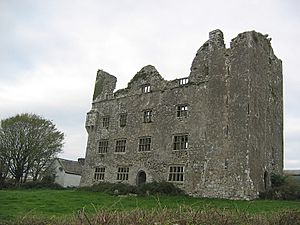Leamaneh Castle facts for kids
Quick facts for kids Leamaneh Castle |
|
|---|---|

The ruins of Leamaneh Castle
|
|
| Location | County Clare, Ireland |
| Built | c. 1480-90 tower house c. 1650 mansion |
| Reference no. | 448 |
| Lua error in Module:Location_map at line 420: attempt to index field 'wikibase' (a nil value). | |
Leamaneh Castle is an old, ruined castle in County Clare, Ireland. It stands between the villages of Corofin and Kilfenora, near a special rocky area called the Burren. The castle is made up of two main parts: a tall, old tower house from the 1400s and a bigger, more comfortable mansion built in the 1600s.
Contents
What's in a Name?
The name "Leamaneh" comes from the Irish language. It probably means "the horse's leap" (léim an éich). Some people think it might also mean "the deer's leap" (léim an fheidh). You might also see it spelled "Lemeneagh Castle."
Where is Leamaneh Castle?
This castle is in a very important spot. It's at a crossroads where three old areas, called Baronies, used to meet: Burren, Corcomroe, and Inchiquin. Today, two main roads, the R476 and the R480, cross paths right there.
Castle History
The First Building
Leamaneh Castle started as a simple, five-story tower house. It was built around 1480-1490. It was likely built by Toirdhealbhach Donn Ó Briain. He was part of the powerful O'Brien dynasty, who were important leaders in Ireland. He was also a direct descendant of the famous Brian Boru.
Later, in 1543, Toirdhealbhach Donn's son, Murrough, gave up his title as King to Henry VIII. In return, he was given new titles: the 1st Earl of Thomond and Baron Inchiquin. In 1550, Murrough gave Leamaneh Castle to his third son, Donough. Donough later faced trouble and was executed in Limerick in 1582.
The Mansion is Added
In 1639, Donough's grandson, Conor O'Brien, married Máire ní Mahon. She became one of the most famous women in Irish stories. Because of her bright red hair, people called her Máire Rúa, which means "Red Mary." She was born around 1615 or 1616. Her father was Sir Torlach Rúa MacMahon, and her mother was Lady Mary O'Brien.
Máire Rúa's first husband, Daniel O'Neylan, died young. When he passed away, she gained control of his large estate and a lot of money. This wealth allowed her and Conor to build a much more comfortable mansion next to the old tower house.
Around 1648, part of the tower house was taken down. A new, four-story mansion was built in its place. Máire Rúa was known for joining her husband on attacks against English settlers. In 1651, Conor was badly hurt while fighting for the Royalists at Inchicronan.
After Conor's death, Máire Rúa quickly tried to protect her family's property. She reportedly went to Limerick and offered to marry any officer from Cromwell's army. This way, she hoped to keep her lands from being taken away. (However, other stories say she didn't marry again until two years after Conor died.)
General Ludlow, who led the English forces, later came to the Burren area. He described Leamaneh as "strong, being built with stone and having a good wall about it." He said they put soldiers there and supplied it with everything needed.
Máire Rúa's third husband was a Cromwellian soldier named Cornet John Cooper. By marrying him, she managed to keep her estates. Cooper left the army and made money by buying and selling land. But he later had money problems. Because of this, the Leamaneh estate, which he now owned through his wife, was used to pay his debts.
In the 1660s, Cromwell's soldiers were sometimes stationed at Leamaneh. Máire Rúa's son, Donagh (later Sir Donat), found the tower and mansion damaged. He lived there until 1684 or 1685. Then, he moved the family's main home to the much larger Dromoland Castle in Newmarket-On-Fergus.
Even though Máire Rúa's children from her first marriage were raised Catholic, Sir Donagh was raised as a Protestant. He became one of the wealthiest people in Ireland who was not a noble. He built "Sir Donat's Road," a toll road connecting Killnaboy and Leamaneh. You can still see parts of its stone walls today. The small buildings where tolls were collected are gone now.
Sir Donagh served as Sheriff of Clare in 1690. He was also a member of the Irish Parliament for Clare from 1695 to 1713. He passed away in 1717. By 1678, the family's land had grown to more than 10,000 acres.
Recent Times
Leamaneh Castle had different people living in it over the years. But by the late 1700s, the house finally became a ruin. The fancy gate towers that stood at the castle's entrance were moved to Dromoland Castle in 1906 or 1908 by Lord Inchiquin. They are still there today.
The most beautiful fireplace from Leamaneh was moved to the "Old Ground Hotel" in Ennis.
Leamaneh Castle Today
Today, you can still see the ruins of Leamaneh Castle. This includes the old tower house with its narrow window openings (called "arrow slits" or "loops"). You can also see the four walls of the mansion, with its special windows that have stone bars (mullioned and transomed windows). The mansion's windows on the upper floors are smaller. This creates an optical illusion, making the building look taller than it is.
You can also find some remains of the smaller buildings and the walled gardens or deer park. Unlike many castles in Ireland, Leamaneh is not looked after. Because it is in poor condition, you cannot go inside. The castle is on private land that is used for farming.


